From this unnatural earth-meat. Andrea Zanzotto, Esistere psichicamente. The dizzying scene from Vertigo is the quintessential mise-en-abyme: Kim Novak (Judy Barton [Madeleine])’s gloved hand runs along the rings that follow on one after the other on the cross-section of the giant sequoia tree. A “manifesto” of a non-sequential, non-linear vertiginating time, which the film reveals and explores (far more explicitly than the previous ones, along the Bruges-la-Morte → Nadja line, as well as of the many more or less post-modernist spin-offs that followed on from Vertigo). Like the Rape of the Lock that, thanks to James Stewart [Scottie]’s Pygmalionism definitively and murderously transforms Judy into Madeleine, like the steps up the oppressive, lethal bell tower at the San Juan Batista mission, and like the abstract opening credits commissioned by Hitchcock from Saul Bass, the succession of events and life-plans twists into a spiral “here I was born... and here I died”.
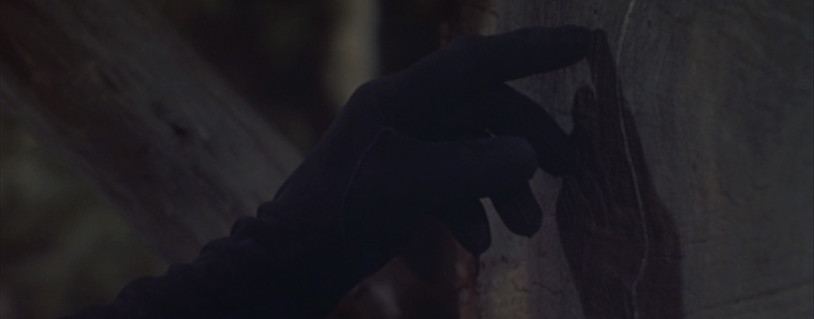
Extracted scene from Vertigo, Alfred Hitchcock, 1958.
The Swedish baron Gerard De Geer did his geochronological research between 1880 and 1910 (he presented it to the International Congress of Geology, in Stockholm, in 1910) but I believe this was due to the Geistzeit rather than to some form of Jungian synchronicity. It was therefore at the same time as the studies that were to lead Freud to his description of the psyche as stratigraphy. Like other key concepts of his, this is an idea that went through a long and tortuous development. In general terms, one might say – as Paul Ricoeur did – that “the theme of the anterior is its obsession”. If this is true, then this theme is specified – in relation to the “topic” of the unconscious, and so, let us say (with James Hillman) to its “topography” – along the conflicting course of Freud’s attraction-repulsion with regard to the ultimate stratigraphic city, which is Rome. And it would indeed be with an example that referred to the Eternal City that the image of the psyche as stratigraphy found its definitive definition (at the height of Civilization and Its Discontents, 1929): “Now let us, by a flight of imagination, suppose that Rome is not a human habitation but a psychical entity with a similarly long and copious past — an entity, that is to say, in which nothing that has once come into existence will have passed away and all the earlier phases of development continue to exist alongside the latest one.” In 1937 Freud would explicitly liken analysis to the “reconstruction proposed by an archaeologist of an entire ancient monument”.
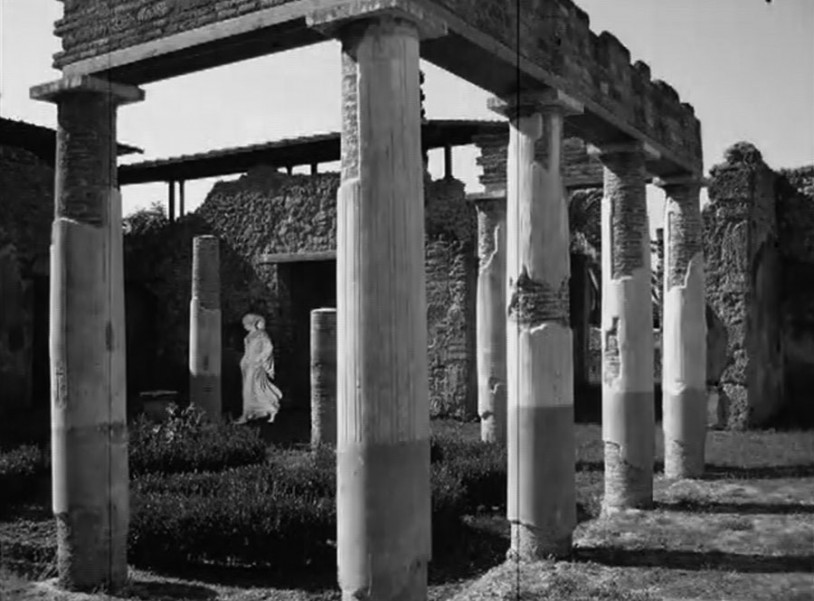
Extracted scene from Journey to Italy, Roberto Rossellini, 1954.
We must not, however, think that wealth, which is a feature of the stratification in this final image, is somehow reassuring. Quite the contrary. When commenting on these texts by Freud, Tommaso Pincio (a writer who, like me, is a citizen of Rome, and who, like me, was born there, but who has never concealed a sense of uneasiness and alienation from the city – which is well expressed in novels like Cinacittà, Panorama and the very latest Il dono di saper vivere – which in turn I know only too well) wrote that “Rome is by no means immortal. Indeed, it has been (and not just once) a dead city, or one that believed it was alive – and this was even before the fall of the Empire.” At least from Piranesi onwards, its romantic and “pre-” myth tells of an interminable succession of overlapping deaths (the “pasta di Martiri” that Alessandro Verri, an explorer fascinated by the catacombs who wrote from his own gilded exile to his still-illuminist, still-Milanese brother Pietro): a palimpsest of impositions and violence that takes its cue from the very act of foundation of the city – the ritual sacrifice of Remus by his brother Romulus. This was shown most recently by William Kentridge (who, at the end of this trail of blood, evokes the corpse of Pasolini face-down at the Idroscalo in Ostia), in the disfigurement-frieze with which he recently paid his ambiguous tribute to Rome. This is a city, this accursed city of mine, which was founded on a murder – or rather, more precisely, on a fratricide (a linguistic root that from Rome reverberates deep into the Italian identity as a whole: revolution is impossible – said Umberto Saba in a famous passage in his Scorciatoie e raccontini – in a country where it is not fathers but brothers that are killed).
Again, Pincio recalls the intolerance for Rome professed by Dostoevsky during a trip in 1863. Unlike the venerable master Gogol, who had stayed there several times, to his great satisfaction twenty years previously, Dostoevsky was brought down and worn out by Rome, especially because of the endless distances he had to walk: “the wonder of Rome is oppressive, excessive, even inhuman. Rome is a place out of all proportion. Its most representative monument, the Colosseum, seems to have been designed for the sole purpose of making men feel miniscule and ridiculous [...]. In Rome, the distances were and remain disproportionate, insensate,” writes Pincio. Forty years previously, Giacomo Leopardi had already complained of this when, after having yearned for so long to go there, he actually found himself staying in “this city that never ends”, between November 1822 and April of the following year (“All the greatness of Rome serves only to multiply the distances [...]. These immense buildings, and these streets that are consequently endless, are as many spaces cast down between men, instead of being spaces that contain men”).
But what is most horrifying about the city is not so much its extent in the horizontal (and its boundless, and now increasingly inhuman, suburbs) as in the vertical. This palimpsest city – in which all the previous ages continue to exist alongside the most recent developments – about which an ultimately heartened Freud would speak, had previously been an authentic nightmare for him. Indeed, it would be more accurate to talk of a complex, which, after all, with his customary self-analytical approach, Freud himself confessed to in his The Interpretation of Dreams (and, in private, in his letters to Wilhelm Fliess during the same period). Before staying there no fewer than seven times, between 1901 and 1923, Freud had tried several times to reach Rome, but always ended up pulling out at the last moment (as had happened – he points out in his book on dreams – to the man who, during his childhood, had been his projective hero: Hannibal, the quintessential enemy of Rome). More than due to some Oedipus-passe-partout (Rome the alma mater of Western civilisation, upon which it fears it might commit incest, as Musatti maintains), or to Freud the Jew’s irremediable aversion to the city that symbolises Christianity (as Timpanaro believes), it may be that what appeared in the form of a phobia was actually the torment of discovery and an archaeology of the profound. The protocols of the latter were announced in the work in which this complex was confessed (but also, in this way, formulated: his long-awaited arrival in the palimpsest-city eventually came, right after the publication of the book). In the end, he recognised these protocols in their geographical etymon.
It is no coincidence that Andrea Zanzotto, the most intensely “psychic” author in twentieth-century Italian literature, entertained a similar degree of ambivalence towards the “darkness” that is to be found “beneath the feet of man”, as he referred to it in an extraordinary page of criticism in 1953, L’inno nel fango. This is the “temporal abyss” that from human history, which is calculated in terms of millennia, expands into geological history, which is measured in “billions of years”. Zanzotto was obsessed with “residues” – “the true lords of the world”, he called them – which are also those of a traumatic history that has never really been fully processed. It is the tragic history of the endless wars of the twentieth century that had been most intense and brutal in the apparently amenable locus of his Venetian Heimat. He himself portrays himself in Fuisse, an incredible poem of the 1950s, as a fossil record that speaks to us from the bowels of the earth, a Self-Exhibit buried in an immemorial past and from there “decanted into the 2000s”. The ambivalence of the earth as a burial profaned without worship is one that is insoluble. It is an arcadia horror from which “pieces of war protruding from the ground” emerge, atrocious and inarticulate. But also – in the same book that is devoted to the massacres of the Age of Extremes, Il Galateo in Bosco – the matrix of biological matter with which his parents “combined him, under that plethora of bones”.
From the lofty classicist Seamus Heaney of Digging, which dates back to his early years in the 1960s, to Valerio Magrelli and his Geologia di un padre, and Tommaso Ottonieri of Geòdi, who are from our present time, many authors have investigated this “archaeological” topic. It is one that, at least from the Romanticism of Chateaubriand and Senancour onwards has often cropped up in literary tradition. The topic involves a sort of short-circuiting between the architecture of our mind, in a more or less Freudian sense, and the structure of time. It could be said that, in a page from 1934 that is as dazzling as it is little-known, Carlo Emilio Gadda was the one who most fully described this short-circuit. Un romanzo giallo nella geologia (reportage from Marsica published five years later in his Meraviglie d’Italia) contains the insight that “the chain of distant causes – which is to say an acquired knowledge of the profound” (according to what Gadda considers a general gnosiological principle, later stated in the Opinione sul neorealismo of the Viaggi la morte) – is indeed to be found archaeologically: in the dialectic between the surface and the subsurface, extension and depth, present and past. As the title of the report indicates, the whole programme of the “metaphysical” detective story was in place for what was to be Gadda’s masterpiece. Quer pasticciaccio brutto de via Merulana (which came, after a very troubled process, in the same year as Zanzotto’s Vocativo) was also the extreme, ultimate work that brought his activity to an end. Underlying the Rome of his day, in the 1940s and ’50s, was the Fascist period of the 1920s and, beneath that, the distant classic onomastic glimmering of the age of Virgil still peeped through. Classic indeed, but of “Freudian” disconcertion, and it is worth remembering how Freud had placed a Virgilian esergo in his The Interpretation of Dreams). Then, going even further back, one reaches, as he himself put it, the “crystallographic suggestion of God”.
Showing more or less human fossil finds on the page (quite apart from its origins, a fossilised human body clearly becomes a geological find), like in the showcase of a museum of natural science or geology, these authors suggest that time, like matter, cannot be read in a sequential, linear manner. Because, as we have seen, the most reliable model is a stratigraphic one in both geology and psychoanalysis: forming a line, it is true, but one that is curved rather than straight, until it bends and crushes itself. A line that ultimately matches, overlaps, and works its way into itself. This is the “geological” model that, in our contemporary way of thinking, was introduced by Gilles Deleuze when he spoke of a morphology of the fold when addressing the subject of the “baroque” episteme that was so dear to Gadda as well as to Zanzotto. Here, he evokes “a cryptography [...] capable of penetrating the folds of matter and, at the same time, reading the folds of the soul.” Like this we find that “the matter-fold is a matter-time” and a “journey through time” thus becomes conceivable. In physical, tangible terms it remains impossible in the Einsteinian sense, whereas in psychic terms (and therefore in material terms, in the Deleuzian sense of immanence) it is something we continually experience. This is indeed the real theme of Vertigo and of the Jetée by Chris Marker (who, after all, takes inspiration from Vertigo) and of Terry Gilliam’s 12 Monkeys (who instead goes back to La Jetée).
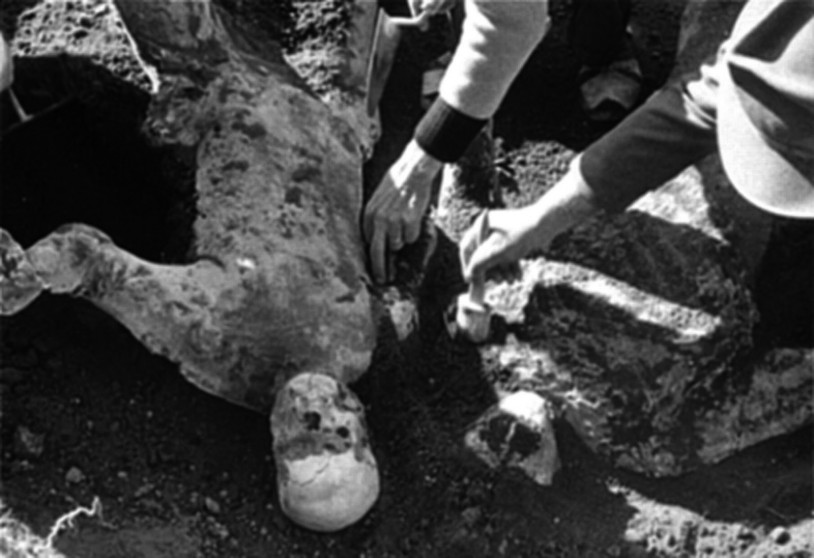
Extracted scene from Journey to Italy, Roberto Rossellini, 1954.
But before all these films there is another one that, at least apparently, has nothing sci-fi or mysterious about it. And that, better than any other, conveyed the dimension that I have so far tried to outline: ending up finding the perfect setting right in the hinterland of Naples. And, it is no coincidence, in what Walter Benjamin called “the porous city”, referring to the etymon that is manifest in the excavations at Pompeii (“all that the visitor desires, admires and pays is ‘Pompeii’”). There is the harrowing fencing match between the icy-cold neurotic British couple Katherina and Alex Joyce (Ingrid Bergman – formerly Hitchcock’s muse, always shown with her delicate hands well protected by gloves – and George Sanders) in Rosselini’s Journey to Italy. These were the last reincarnation of the Grand Tour travellers of yore, and the scene is set entirely in the magical enclosure with the Solfatare of Pozzuoli, the Fontanelle alla Sanità cemetery – and indeed Pompeii itself. Georges Didi-Huberman, the greatest thinker in the world of art today, referring to that old page written by Benjamin, exemplified his anachronistic conception of history not only of images (a conception explicitly inspired by Benjamin, as well as by Warburgh), in none other than these Neapolitan sites where we find the same stratification that Freud foretold in Rome: “As in every city that has lived many times, here they overlap, bursting into each other even physically”. Referring to the capuzzelle, the countless skulls at Fontanelle lined up in overlapping layers like terracotta armies stacked one on top of the other: “In this architecture we see violent, almost Piranesi-like shafts of light, which coexist with the shapeless loam of death, and with the carpet of bones at its base.” It is in places like these that we witness the “emergence of the heterogeneous: where different ages intertwine, and become encrusted in one another.” Here “this multiple, unclean temporality that is intrinsic in art comes to life. The forms of art always refer to a depth that is beyond, something secretly radiant that is below and that keeps on pulsating.”
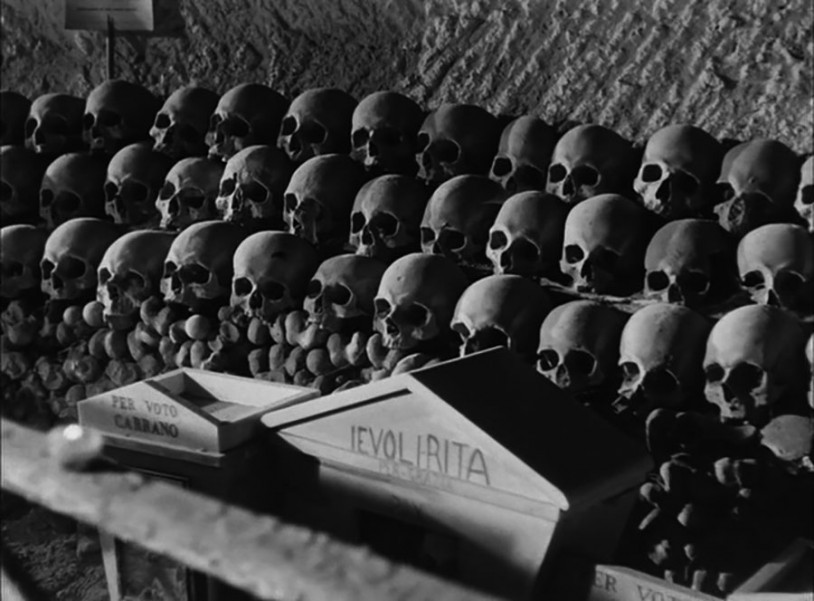
Extracted scene from Journey to Italy, Roberto Rossellini, 1954.
It was this dynamic, disturbing pulsation – conveyed by the mortal remains that, in the form of plaster casts, literally emerge from the ground in Pompeii – that caused such anguish to Ingrid Bergman (Katharine Joyce) in Rossellini’s film. In a man and a woman caught unawares by the fury of the earth two thousand years previously, and from the archives of the earth, entwined in each other for all eternity, but suddenly laid bare by the indiscreet eyes of the archaeologist, she sees their own destiny as a couple as though in a dream: an intolerable death in life and yet tolerated in silence for years on end. Only then, says Martin Scorsese, “their eyes open at last”. She, as troubled as ever, exclaims “life is so short”; to which he responds brusquely: “that’s why one should make the most of it.” At the end of Fuisse, Zanotto’s Self-Fossil “poured out of nothing” into the “strata of the earth” that “fall back into silence”, though with a qualifying question mark, telling us that it is “also for us” that these “lips”, in spite of everything, “move weakly from absence”.
It really is true that the future has an ancient heart.
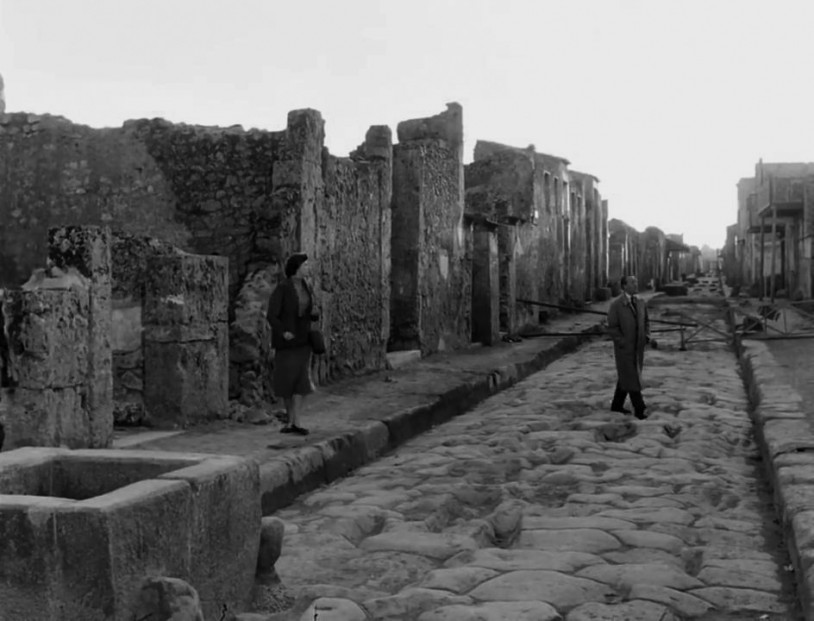
Extracted scene from Journey to Italy, Roberto Rossellini, 1954.
Note
Vertigo, directed by Alfred Hitchcock, 1958 (in Italy La donna che visse due volte, from the 1954 novel by Thomas Narcejac and Pierre Boileau, D’entre les morts, most recently published as La donna che visse due volte by Adelphi, translated by Federica Di Lella and Giuseppe Girimonti Greco, in 2016; see Victor I. Stoichita, Effetto Pigmalione. Breve storia dei simulacri da Ovidio a Hitchcock [The Pygmalion Effect: From Ovid to Hitchcock] translated by Benedetta Sforza, ed. Aurelio Pino, il Saggiatore 2006; Madeleine’s words in the Muir Woods: https://www.youtube.com/watch?v=IJpo-z2m3dI). Georges Rodenbach, Bruges-la-Morte [1892], most recently in the translation by Paola Decina Lombardi, Bruges la morta, Mondadori 1997 (see Emanuele Trevi, Il demone della somiglianza, afterword in the edition with the same title translated by Catherine McGilvray, Fazi 1996 – not included in the recent reprint, ibid 2016); André Breton, Nadja [1928]; there is a new edition of the translation by Giordano Falzoni with a preface by Domenico Scarpa, Einaudi 2007, but the first Italian edition is preferable, with a note by Lino Gabellone, ibid 1972 (refer to my “Bruges-la-Morte, Nadja, Vertigo. Psicologia di tre città”, in Dal Nulla al Sogno. Dada e surrealismo dalla Collezione del Museo Boijmans Van Beuningen, catalogue of the exhibition in Alba, Fondazione Ferrero, 27 October-25 February 2019, ed. Marco Vallora, Silvana 2018, pp. 334-43).
Quotations from Sigmund Freud’s Il disagio della civiltà [Civilization and Its Discontents, 1929], in Id., Opere, ed. Cesare Musatti, vol. X, Boringhieri 1978 (p. 563), Costruzioni nell’analisi [1937], in Id., Opere, cit., vol. XI, ibid 1979 (p. 545) and L’interpretazione dei sogni [The Interpretation of Dreams, 1899], in Id., Opere, ed. cit., vol. III, ibid 1966 (pp. 185 ff.; the exergue mentioned below is “Flectere si nequeo Superos, Acheronta movebo”, from Book VII of the Aeneid, which is to say “the hidden, invisible part of reality is not less important than the visible”: Carlo Ginzburg, Spie [1979], in Id., Miti emblemi spie. Morfologia e storia, Einaudi 1986, p. 197n); see Paul Ricoeur, Della interpretazione. Saggio su Freud [Freud and Philosophy: An Essay on Interpretation, 1965], translation by Emilio Renzi, il melangolo 1991, p. 405; and James Hillman, Il sogno e il mondo infero [Dream and the Underworld, 1979], translation by Adriana Bottini, Adelphi 2003, pp. 28 ff. (and see pp. 233 ff.). Taken up by Tommaso Pincio in the chapter “Criptoamnesie”, on pp. 61-77 of his Pulp Roma, il Saggiatore 2012 (here also the comment on Dostoevsky, pp. 16-7; the reference is to the letter of September 1863, which appears in Fyodor M. Dostoevsky, I demoni quotidiani. Lettere, ed. Ettore Lo Gatto, vol. I, 1837-1867, Aragno 2017, pp. 299 ff.) and Vittorio Lingiardi in Mindscapes. Psiche nel paesaggio, Cortina 2017, pp. 125-7 and 137-42 (but the fiercest comment, an authentic relentless single combat, is that of Sebastiano Timpanaro in “La ‘fobìa romana’ di Freud”, an article written in 1985 that became a small volume in 1992 and was further expanded in Id., La fobìa romana» e altri scritti su Freud e Meringer, ed. Alessandro Pagnini, ETS 2006, pp. 53-110; see Cesare Musatti, “Freud e l’ebraismo”, in Belfagor, XXXV, 1980, pp. 687-96; then in Id., Ebraismo e psicoanalisi. Il pensiero politico e sociale di Freud, Studio Tesi 1994).
The “pasta di Martiri” was found by Alessandro Verri during his explorations of the catacombs in Rome, and described in a letter to his brother Pietro dated January 1793 (“In the catacombs of San Lorenzo I found many bones, and they have been reduced by time to something like a pure paste, which they call the pasta di Martiri, and I also found some unopened tomb holes, which I opened and found the usual skeletons”: see my “L’antiquario fanatico e l’ombra di Vitruvio. Sincretismo estetico delle Notti Romane di Alessandro Verri”, in Italia e Italie. Immagini tra Rivoluzione e Restaurazione, proceedings of the conference in Rome, 7-9 November 1996, by Mariasilvia Tatti, Bulzoni 1999, pp. 346-7). Triumphs and Laments is the title of the mural, measuring over five hundred metres in length created by William Kentridge, in the spring of 2016, between the Ponte Sisto and the Ponte Mazzini (see my “William Kentridge, il tempo che scorre”, in alfabeta2, 14 May 2016, on pp. 291-3 of Almanacco 2017. L’invasione aliena, curated by Nanni Balestrini, Maria Teresa Carbone and myself, DeriveApprodi 2016). Umberto Saba’s “shortcut” number 4 is mentioned, and it ends like this: “The Italians want to give themselves to their father and, in exchange, to receive his permission to kill their other siblings” (Scorciatoie e raccontini [1946], in Id., Tutte le prose, ed. Arrigo Stara, introduction by Mario Lavagetto, Mondadori 2001, p. 8). Giacomo Leopardi’s letters to his father Monaldo on 22 December 1831 and to his sister Paolina on 3 December 1822 are also mentioned (on p. 80 and on p. 10 in Id., Questa città che non finisce mai. Lettere da Roma 1822-32, afterword by Emanuele Trevi, Utet 2014).
Andrea Zanzotto’s essay (on Montale) L’inno del fango, of 1953, in Id., Fantasie di avvicinamento [1991], in Id., Scritti sulla letteratura, ed. Gian Mario Villalta, Mondadori 2001, vol. I, p. 18; and the poems Fuisse in Id., Vocativo [1957], and Rivolgersi agli ossari in Id., Il Galateo in Bosco [1978], in Id., Le Poesie e Prose scelte, ed. Stefano Dal Bianco and Gian Mario Villalta, introductory essays by Stefano Agosti and Fernando Bandini, Mondadori 1999, pp. 186 ff. and 565-6 (but the geological topic extends all the way to the final work Conglomerati, Mondadori 2009), and the interview La poesia e il sublime, which emerged from talks I had with him between 2002 and 2005, in Galatea. European magazine, November 2005, pp. 30-7. No less psychic is Tommaso Ottonieri’s Strade che portano al Fùcino, Le Lettere 2008, and Geòdi, Aragno 2015; as well as Valerio Magrelli’s Geologia di un padre, Einaudi 2013 (prose in which a long-running topic takes shape – see Valerio Magrelli, l’occhio, la terra, la salute, in my La fisica del senso.. Saggi e interventi su poeti italiani 1940-2005, Fazi 2006, pp. 410-37 and 733-43). Scavare (Digging) is the first poem in the first collection in Italian of Seamus Heaney, Morte di un naturalista, published in 1966 (now in Id., Poesie chosen and collected by the author, ed. Marco Sonzogni, Mondadori 2016, pp. 6-9); with L’uomo di Grauballe (poem in the collection North, 1975, ibid, pp. 142-5) Heaney also launched a tradition of unusual (but not coincidental) success in Italy – turning human finds unearthed in more or less prehistoric deposits into an allegory of the persistence of the phylogenetic memory that underlies the chronological progress of actual historiography. It is taken up by Fabio Pusterla in Bocksten, Marcos y Marcos 1989 (pp. 25-79) and Franco Buffoni in Tecniche di indagine criminale, in Id., Il profilo del Rosa [2000], in Id., Poesie 1975-2012, ed Massimo Gezzi, Mondadori 2012 (p. 120) and in Nel più alto campo di battaglia, in Id., Guerra [2005], ibid (p. 221). On all of this, see the chapter “Post-Factum. La guerra postuma” in my Le notti chiare erano tutte un’alba. Antologia dei poeti italiani nella Prima guerra mondiale [1998], Bompiani 20182 (pp. 619-66; and see Matteo Giancotti, Paesaggi del trauma, Bompiani 2017).
Quotes from Gadda are from Un romanzo giallo nella geologia [1934], in Id., Le meraviglie d’Italia [1939], ed. Liliana Orlando in Id., Opere, edition directed by Dante Isella, Saggi giornali favole-I, Garzanti 1991, pp. 145-51; Quer pasticciaccio brutto de via Merulana [1957], ed. Giorgio Pinotti, Adelphi 2018, p. 255; Un’opinione sul neorealismo [1951], in Id., I viaggi la morte [1958], in Id., Saggi giornali favole-I, cit., pp. 629-30: “A reader of Kant cannot believe in an objective reality that is isolated and suspended in a void; but he has a sense of reality, or rather of the phenomenon, as though it were a kaleidoscopic semblance behind which a truer, more subtly operative quid is concealed, like the way a clock face conceals its secret inner machinations “(on this subject, see Giancarlo Alfano, Percorsi orizzontali e vettori verticali. Lo spazio nel Pasticciaccio, in Id., Paesaggi mappe tracciati. Cinque studi su letteratura e geografia, Liguori 2010, pp. 71-90). La Jetée, directed by Chris Marker, 1962 (Marker has written some very interesting pages on Vertigo in A free replay. Notes sur “Vertigo”, in Le cinéma vu par les cinéastes, monographic issue of Positif, 400, June 1994, pp. 79-84); 12 Monkeys, directed by Terry Gilliam, 1995. Gilles Deleuze is quoted from La piega. Leibniz e il Barocco [1988], ed. Davide Tarizzo, Einaudi 2004 (quotations on p. 6 and p. 11).
The famous definition of Naples as a “porous city” appears in the prose piece written by Walter Benjamin together with Asja Lacis, Napoli, published in 1925 in the Frankfurter Zeitung (in the Italian translation, in 1979, in issue 9-10 of the magazine Es; now in the translation by Helmut Riediger, in Id., Opere complete, ed. Rolf Tiedemann and Hermann Schweppenhäuser, Italian edition ed. Enrico Ganni, vol. II, Scritti 1923-1927, Einaudi 2001, pp. 37-46, quotation on p. 38). Viaggio in Italia, directed by Roberto Rossellini, 1954 (here, https://www.youtube.com/watch?v=9DW-Zb-HESo, the Pompeii scene with off-screen comment by Martin Scorsese, from his documentary on editing, which takes its title from Rossellini’s film, Il mio viaggio in Italia of 1999; YouTube also has the full version of Viaggio in Italia, restored in 2012: https://www.youtube.com/watch?v=CJ9e0ReGwy8). Mention is made of my interview with Georges Didi-Huberman in 2008, at the Fontanelle Cemetery, on the occasion of the Premio Napoli, which he won with his essay Ex voto (published that year by Cortina): Necropoli in fiamme, in Il Caffè illustrato, VIII, 46-47, January-April 2009, pp. 87-8 (see his magnificent Storia dell’arte e anacronismo delle immagini [2000], translation by Stefano Chiodi, Bollati Boringhieri 2007, and L’immagine insepolta. Aby Warburg, la memoria dei fantasmi e la storia dell’arte [2002], translation by Alessandro Serra, ibid 2006).


